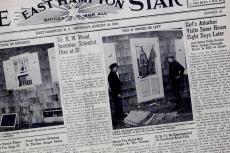At the East Hampton Village Zoning Board of Appeals meeting on June 17, Acacia L.L.C., the owner of 8 Marina Lane, asked to reopen its application for a sunken tennis court.
Marina Lane is a small cul-de-sac off East Hollow Road. Acacia owns two adjacent parcels there, one containing the main residence. The L.L.C. bought the adjacent lot to build a tennis court; it contains another house that would be demolished. It was not originally planned to tear down the second house, but that is now the objective: According to the revised application, it would allow for a better court placement in relation to the main lot.
“They’re moving the project further from our shared common boundary line, and therefore requesting a smaller variance,” Jon Tarbet, a land-use lawyer representing the limited liability corporation, told the zoning board.
The Z.B.A. had approved the original application, but with a restrictive covenant, requiring that the court be removed as a condition of any sale. Additionally, the board stipulated that no other variances would be granted concerning any structure proposed for the second (tennis court) parcel. The applicant is now seeking to build a small house there, and needs a setback variance (from its own property line) to make it possible.
Board members seemed surprised by the small size of the structure being proposed: 1,200 square feet. “Why would they be going so small?” wondered Jim McMullan, vice chairman of the board, when the lot allows for a nearly 8,000-square-foot house.
This is not a common question at a village Z.B.A. meeting.
“For 90 percent of my career,” Mr. Tarbet replied, “people were just buying a piece of property and developing it to the maximum potential. Now we’re seeing more and more people own the property next to them . . . and people are basically putting together estates again.”
The only reason for having a house on the second property at all, he explained, is that “the code says, that in order to have a tennis court, you need to have a primary structure.”
A brief discussion followed about what constituted a “sunken court.” In the past, applicants have claimed their court was “sunk” if it was just six inches below grade. “Four feet is conventional for a sunken court” said Bill Hajek, the village planner. He suggested the board condition an approval of the court on its being sunk to that depth, explaining later by email that tennis courts are sunk for aesthetic reasons, but also to mitigate noise concerns.
Mr. Tarbet said his clients had no problem with that.



